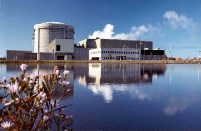Point Lepreau refurbishment schedule 'achievable'
30 November 2010
While work continues to refurbish the Point Lepreau nuclear power plant in New Brunswick, Canada, NB Power has said that the project schedule to return the plant to service in late 2012 is "achievable."
 |
| Point Lepreau (Image: NB Power) |
The single reactor at Point Lepreau, which provides up to 30% of New Brunswick's electricity, was shut down at the end of March 2008 for a refurbishment outage expected to last some 16 months. The main activities to be conducted during the outage include the replacement of all 380 fuel channels, calandria tubes and feeder tubes, as well as other station maintenance work. The C$1.4 billion ($1.4 billion) refurbishment of the 680 MWe Candu 6 pressurized heavy water plant, which began commercial operation in 1983, will extend its operation by an additional 25 to 30 years.
However, the initial attempt to replace the calandria tubes at Point Lepreau was not successful because of problems with the tightness of the seals obtained.
In mid-October, Atomic Energy of Canada Ltd (AECL) recommended that all 380 calandria tubes in the reactor should be removed and replaced, and the tube sheets polished to ensure an adequate fit. Under a revised project schedule, this should be completed by May 2012.
NB Power says that it has now reviewed the project schedule "to better understand the impact of the AECL revised scheduled completion date on the overall project activities and is satisfied with the timeline that AECL provided." The company added, "barring unforeseen circumstances, this new schedule is achievable."
On completion of the retubing activities, NB Power will proceed with commissioning activities which "will take approximately four months in order to safely return the reactor to service in the fall of 2012, ready for the heating season."
In a statement, NB Power noted, "Although the calandria tube installation work sequence will take longer to complete than previously planned, it is essential that these activities achieve the required quality standards in order to provide safe and reliable operation for the next 25 to 30 years."
"Replacement of the calandria tubes involves removing 760 calandria tube inserts that hold the calandria tubes in place; removing 380 calandria tubes; polishing and cleaning the tube sheet bores; and then inserting new calandria tubes," the company said.
A detailed readiness review of the tube sheet bore cleaning and polishing procedures and tools has been completed. The assessment was verified in the field in August 2010 by removing eight calandria tubes, polishing their bores, re-installing and rolling the calandria tubes and successfully leak testing the rolled joints.
Training on the procedures and tooling is on-going at the AECL mock-up training facility in Saint John. Crews are now preparing to install the polishing tools at the Point Lepreau plant as a prerequisite to installing the remaining 372 calandria tubes.
Researched and written
by World Nuclear News